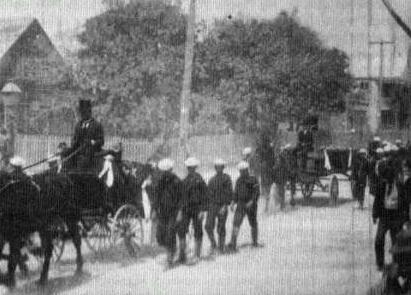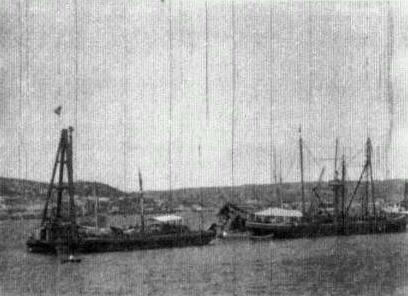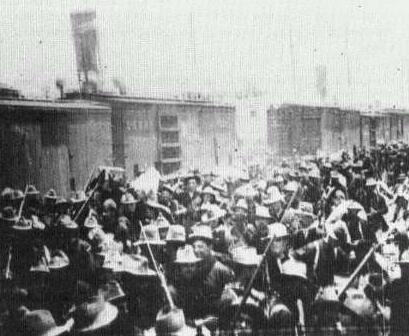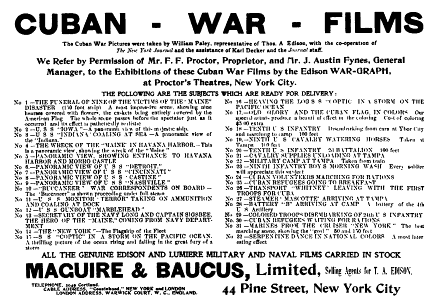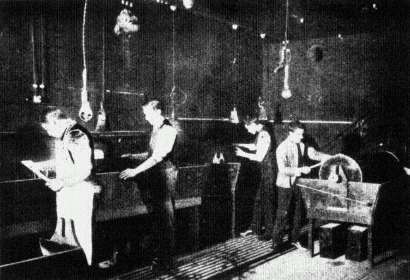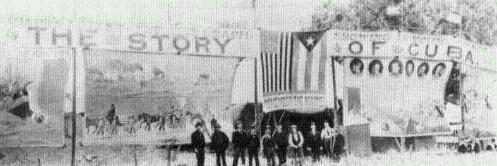The Spanish-American War
The sinking of the Maine and the Spanish-American War were a boon to the American film industry, as cinema regained a wide audience. Prior to these events, New York exhibitors were suffering through yet another period of underutilization. Even Keith's had let the Biograph service go after a year-long run. Once again, the Eden Musee was the only amusement center advertising a film exhibition in local papers.[71] When Biograph opened at Proctor's Pleasure Palace on February 14th, this situation would not have changed significantly— except that the Maine was blown up in Havana Harbor the following day.
Within a week after the explosion, Pleasure Palace audiences were seeing "the ill-fated Battleship Maine" — actually a film of her sister ship—on the screen. The Musee, which had previously highlighted developments in Cuba, may have hired Biograph to show similar films when the Musee's cinemato-
graph was not showing The Passion Play .[72] By mid March, the "wonderful Biograph" was arousing patriotic enthusiasm with scenes related to the Maine , views of the Spanish ship Vizcaya , which had recently visited New York harbor, and "counterfeit presentments" of Consul General Fitzhugh Lee, who headed the inquiry into the "Maine" explosion, and of Charles Sigsbee, the ship's captain. Such inflammatory subjects were deemed "highly instructive."[73]
As President McKinley wavered between war and reconciliation with Spain, the "new" or "yellow" journalism of William Randolph Hearst's New York Journal and Joseph Pulitzer's New York World worked hand in hand with the music halls and theaters to incite Americans' warlike spirit. During the early part of the day, many New Yorkers read detailed descriptions of the latest Spanish atrocities and perused Journal editorials that declared, "A war would show first of all, what sort of stuff this country is made of, and what kind of men it has produced in the last thirty years."[74] Later in the day, these people might attend the theater, where patriotic songs encouraged group demonstrations. Biograph's exhibitions often provoked loud applause or hisses (depending on the subject). A film of the American flag at the conclusion of each program guaranteed long, hysterical cheers. The press gave such outbursts extensive coverage, and the World claimed that they indicated "the temper of the people in the present crisis."[75] Audience enthusiasm encouraged the Biograph Company to send cameramen to Havana, where they photographed noteworthy scenes. At the end of March, these films were being shown at the Pleasure Palace. These "Life-Motion Views" presented "the Wreck of the Maine, Divers Ascending and Descending, Consul General Lee at His Residence, The Reconcentrados, etc."[76] A week later, the Eden Musee was showing the same Biograph views. "The workings of the divers are plainly seen," reported the Mail and Express . "These views aroused much enthusiasm, and when a fluttering United States flag was shown nearly everyone present, including women, cheered."[77]
Neither the Edison Company nor the Eden Musee could afford to tolerate the Biograph Company's monopoly of war films. Biograph was Edison's major commercial rival, while the Musee had few war subjects for its cinematograph and was forced to spend substantial sums on the Biograph service, which nonetheless first exhibited its films elsewhere. These organizations and Edison's selling agent F. Z Maguire accordingly made arrangements with Hearst's New York Journal and dispatched William Paley to Florida and Cuba.[78] Hearst not only made his news yachts available to the Edison cameraman for transportation and as a platform for taking films, he paid for Paley's trip.[79] His was "the journalism that acts."[80]
Paley, still recovering from an illness, left his sickbed in mid March and headed for Key West, Florida.[81] There he worked closely with Karl C. Decker, a Hearst journalist, taking one-shot films related to the crisis. On the 27th he filmed Burial of the "Maine" Victims . For War Correspondents , the two staged
Burial of the "Maine" Victims.
a good-natured foot race among reporters, who were supposedly taking "war copy" to the telegraph office. Decker followed up the rear in a carriage, coming in last. (The Journal , failing to see the humor in this arrangement, described the scene by asserting that Decker beat his rivals.) Another film depicted Decker on the decks of the Journal's despatch yacht Buccaneer . Paley and Decker also used the despatch yacht's decks for filming views of Admiral Sampson's fleet in the Dry Tortugas, southwest of Key West (U.S. Battleship "Iowa ").[82] Although the cameraman and journalist made three attempts to film in the vicinity of Havana Harbor, only two scenes were successfully taken: Wreck of the Battleship "Maine " and Morro Castle, Havana Harbor .[83] In fact, with the sole exception of Burial of the "Maine" Victims (150 feet), all the films were only 50 feet in length—ideally suited for the active editorial intervention of the exhibitor (see document no. 6).
Wreck of the Battleship "Maine."
DOCUMENT NO . 6 |
JOURNAL PICTURES OF WAR CHEERED. |
Crowd at Proctor's Theatre |
Shows Its Approval of Enterprise. |
A TRAGEDY OF MOVEMENT. |
Funeral of the Maine Victims Enrages the Big Audience. |
At Proctor's Theatre last night enthusiastic crowds cheered the Journal to the echo as they watched the War-graph throw upon the giant screen the pictures which the Journal's correspondents had secured of the scenes attending the prosecution of the war in Cuba. |
In these days of excitement it takes a good deal to stir a big theatre audience to any great display of feeling unless applause is drawn from it by patriotic songs and a liberal waving of flags, but the people last night showed that they appreciated the service the Journal has done for humanity by giving to the simple black and white depiction of the War-graph the same outburst of applause that greeted the National anthem. |
There were pictures of all sorts, the grave, the gay and the grewsome [sic ]. The battle ship Maine was shown as she steamed serenely into Havana harbor and then, later, there were thrown upon the screen the Journal's own picture of the wreck, the skeleton arms of the wrecking derricks |
(Text box continued on next page)
stretched above her and the buzzard like fleet of Spanish patrol boats circling about that which was once a ship of the United States Navy. |
It may have been accident or design that made the operator slip in a slide that threw the banner of Spain on the screen, but the hisses that assailed it fluttered the curtains and caused a man who had tucked a wide brimmed hat under his chair to make a suggestive move toward his hip pocket. Then there followed upon the screen the title: "Funeral of the Victims of the Blowing Up of the Maine." |
When the glitter of the wargraph shone out again it showed a scene familiar enough, in its crystallized state, to the readers of the Journal, but which, when shown as it was at Proctor's Theatre last night, gained a significance and a reality that no newspaper could produce. |
The orchestra hushed and a bugler behind the scenes began to play that sad, last call, "Taps," as a company of blue jackets swung around the corner of the pictured scene. In the midst of them could be plainly distinguished a dingy, one-horse landau, with a crepe-draped coffin within it. |
"One," said the spectators. Next second it was "Two," and so the grim count went on. There seemed to be miles of that awful procession of the dead, which the Journal's camera had caught. It was not mere photographic repetition: the crowd soon saw that. It was the real thing, and as the full horror of that cowardly murder swept through the theatre a sigh went up that not even the lighter pictures which followed could change to a smile. |
During an interval James Thornton, the comedian, read from the stage some of the Journal's bulletins of the progress of the war, and more cheers were given for American successes. |
Then followed more pictures: The race of the newspaper correspondents in Havana to catch the outgoing boat with a red-hot piece of news; General Lee descending the steps of the American Consulate; the distribution by the Journal of supplies and medicines to the starving reconcentrados, and a picture of the President. |
General Lee seems to be the popular hero of these days. He gets every bit as much cheering as the President, if not a little more. Another thing that the crowd at Proctor's Theatre showed was that not even the fever of war can take the innate chivalry out of the American people. It is the custom to announce every picture before it is thrown on the screen, and the advance sign said "The Queen Regent of Spain." |
There were some scattering hisses, but when the projector threw upon the canvas the pictures of a woman—a woman who looked as if she had suffered—the hisses died away. Once again there was a flicker and the sign said "The King of Spain." Again came the hisses, but when there was shown out on the screen the picture of a little boy in knickerbockers, |
(Text box continued on next page)
sitting in a chair that looked several sizes too large for him and wearing a distinctly pathetic appearance, the hisses vanished in a flutter of actual applause and a feminine murmur of "Oh, pshaw, he's only a little bit of a boy." |
SOURCE : New York Journal and Advertiser , April 26, 1898, p. 13. This exhibition was almost certainly mounted by the American Cinematograph Company, with which Porter was associated. Several things may be noted about this account. Some films, for instance War Correspondents , were given a different context (Havana rather than Key West). The exhibition included as many slides as films: not only title slides but photographs of the Spanish flag, queen and king. Although the presentation reveals only a tentative narrative progression, the program was devoted to a single subject around which the audience's emotions were skillfully manipulated. |
Less than a week after Paley's return, his pictures had been copyrighted by Thomas Edison and prints were being sold to impatient film exhibitors. The demand was so great that Paley, who had returned to New York on April 15th, returned to Florida on April 21st in anticipation of a declaration of war, which came four days later. Maguire advanced $500 to Paley against the cameraman's future royalties and may have provided him with film stock, but he told Gilmore: "As Mr. Paley is practically spending his own money, you can readily understand that this is a very good arrangement for us. The trip will practically cost us nothing."[84]
On his second trip, Paley went to Tampa, Florida, and photographed scenes of military preparations (10th U.S. Infantry Disembarking from Cars ) and everyday scenes of military life (9th Infantry Boys' Morning Wash ). Several views of Cuban refugees were also taken (Cuban Refugees Waiting for Rations ). Camp scenes became more and more common as Paley waited for the invasion of Cuba to commence (Blanket Tossing a New Recruit and 9th and 13th U.S. Infantry at Battalion Drill ). On June 8th, the patient cameraman took Roosevelt's Rough Riders Embarking for Santiago and other scenes of troops boarding transports. The soldiers baked for a week under Tampa's ferocious sun; it was not until June 22d that they landed at Baiquiri, Cuba (commonly spelt "Daiquiri"). Paley along with other correspondents probably accompanied the convoy on the Olivette. U.S. Troops Landing at Daiquiri, Cuba and Mules Swimming Ashore at Daiquiri, Cuba perhaps taken from this ship, were said to be of the first American soldiers to reach Cuban soil.[85]
Once Paley reached Cuban soil, transporting the portly cameraman and his equipment proved a nightmarish task, particularly with the shortage of horses. Aided by an army teamster, he finally reached general headquarters and photographed Major General Shafter , showing the obese commander astride his horse. Paley took only a few additional subjects (Troops Making a Military Road in Front of Santiago; Packing Ammunition on Mules, Cuba ) before disaster struck. The wagon carrying his baggage broke down, exposing photogra-
71st N.Y. Volunteers Embarking for Santiago.
pher and apparatus to a night-long rainstorm. The camera stopped working, Paley came down with a fever, and his Cuban expedition was ended. With the assistance of Charles E. Hands of the London Daily Mail , he reached a resupply point and went home dangerously ill.[86]
By April 18th, Paley's films were being shown at the Eden Musee, which acted as a center for war news and patriotic demonstrations:
The Cuban wax works attracted much attention there last evening and the new figure of General Lee was continually surrounded by his admirers. The orchestra gave a concert of patriotic selections, including the battle hymns of civilized countries. The cinematograph exhibited new pictures taken in and about Havana Harbor by the Musee's artist and also pictures of American battleships at anchor and in movements, cavalry dashes, sham battles and National Guards on the march. Frequently the patriotism of the audience would rise to such an extent that there would be cheering.[87]
Enjoying its own supply of war films (via Paley), the Musee ended its Passion Play performances on May 4th, after two hundred exhibitions. Henceforth, all its energies were concentrated on sustaining the bellicose mood of New Yorkers. On May 7th, a week after Commodore George Dewey's victory in Manila Bay,
Advertisement for Edison "War Films."
his wax figure was on display in the Musee foyer. Meanwhile, Porter and his immediate boss, Eugene Elmore, showed "scenes from Havana, of the American warships, the sunken Maine, the Maine crew, burial of the Maine sailors and other views taken in and about Havana harbor and Key West. In addition are views of sham battles, infantry maneuvers and target practice."[88] Exhibitions devoted exclusively to the war were given hourly. Some focused on a particular aspect of the struggle, while others were more eclectic. New views were shown on a weekly basis into the summer. Many "were taken by the Musee's own artist, and are different from those shown at other places."[89]
The Cuban crisis and Spanish-American war brought moving pictures into an unprecedented number of metropolitan theaters.[90] One week after war was declared, the Eden Musee was one of at least seven Manhattan theaters showing war films—one more than at the novelty highpoint a year and a half earlier.[91] Porter and his associates at the American Cinematograph Company operated one of several exhibition services that took advantage of the resulting demand for film programs. In a later interview, Porter stated that he and William Beadnell supplied several vaudeville houses with film turns. "We had machines in the Eden Musee, in the Proctor houses and also some of Percy Williams."[92] Spring programs at Proctor's 23rd Street Theater were consistent with the supply of films available down the street at the Eden Musee, but the American cinematograph was replaced by Blackton and Smith's burgeoning American
Developing motion picture film in 1898-99.
Vitagraph Company toward the end of June. Blackton and Smith had developed a secret reframing device that improved their exhibitions. They had also established their own production capabilities. Since the American Cinematograph Company had to give preferential treatment to the Musee, the switch was a logical one.
Porter and Elmore were partially responsible for the addition of American Vitagraph to the Edison stable of licensees.[93] Perhaps they visited Blackton and Smith's offices to gather evidence of illegality that would enable them to regain their old outlet at Proctor's. Or perhaps they hoped to purchase some of Blackton and Smith's original productions to enhance their collection. Instead, they and other potential purchasers found dupes of Paley's war films. Thomas Edison soon sued Vitagraph for copyright and patent infringement, with Elmore and Porter providing depositions to support the case. Caught red-handed, Blackton and Smith reached an agreement with William Gilmore whereby they would not contest Edison's suit, but would work under a licensing arrangement similar to that made with the Eden Musee and William Paley.
Programs at the Musee were being constantly updated and changed, a challenging task for Porter and Elmore, who had to experiment with novel combinations of subjects. In June moving pictures were exhibited while a soloist sang national airs.[94] Later in the month, with the largest collection of war films in the city, the Musee began to show them all on Sundays at 3 and 9, giving "an
opportunity to thousands to see these remarkable pictures at a slight cost."[95] The Musee's motion picture operators arranged the films as a chronology of the war: "The Maine sailors on parade are shown and then the Maine sailing into Havana harbor. Following is the burial of the Maine sailors, General Lee at Havana, other scenes in and about Havana, the various camps, soldiers at drill, battleships at anchor and in action, troops leaving Tampa for Santiago and other equally vivid scenes up to the storming of Santiago."[96] Audience response to the films was so enthusiastic that many of the pictures had to be shown a second time.[97]
The Eden Musee generally used its screen as a kind of patriotic news service. In August the entertainment center was showing one new war view each day. With over one hundred films in its collection, the motion picture operators showed twelve views each hour during the week, changing subjects each hour so visitors could stay as long as they liked and see different views.[98] By the end of August, their collection had swelled to nearly two hundred.[99] As soldiers returned from war in September, the Musee enjoyed a special kind of status:
The Eden Musee is becoming a headquarters for the soldiers in this city. Since they returned scarcely a day passes that at least 500 do not visit the Musee. The majority of the Rough Riders have been there. They praise the war groups and take the greatest interest in the war pictures. The pictures taken in and about Santiago are cheered, and often have to be shown again. The other visitors take almost as much interest in the soldiers as in the attractions at the Musee. Little groups frequently surround the soldiers and question them about the war, and there is not an attendant in the house who has not a choice collection of souvenirs given him by the soldiers. On Wednesday Gen. Wheeler dropped into the Musee. He was recognized almost instantly and received cheers and greetings from the soldiers and visitors. One of the Musee's artists made sketches, and a figure of the popular hero will soon be on exhibition.[100]
The Eden Musee was thus dedicated to heroicizing the United States' imperial adventures and those who implemented its policy—not least of whom was Col. Theodore Roosevelt, soon to be elected governor of New York.
By November, Porter and Elmore had responded to the fading popularity of war views by taking a more documentary-like approach to their subject matter.[101] As the Musee announced,
Since the beginning of the war with Spain cinematograph war views have been shown at the Eden Musee. The Musee's own artist took the pictures, and as fast as they were developed, they were shown. A genuine novelty in these pictures has now been arranged. It is the nature of a panorama of the whole war. The moving picture scenes begin with the arrival of soldiers at Tampa and include various important movements that followed, up to the surrender of Santiago. Over twenty views are shown. Among them are the Red Cross upon the field, Colonel Astor setting out to meet General Toral, artillery practice, Rough Riders landing, battle of San Juan, troopships in a storm, the surrender of General Toral, the raising of the Stars and Stripes over Santiago
and many other important scenes. All the pictures are accompanied by ingenious effects, including martial music, firing of guns and wind and rain.[102]
The Musee staff moved toward an increasingly elaborate, narrative account of the war. While it is impossible to ascertain Porter's precise contribution to the construction of program-length narratives such as Panorama of the War , as the Musee's chief motion picture operator he must have been intimately involved in the editorial process. Although this creation of complex film programs with extended narrative sequences was then common,[103] the Musee's unique position encouraged experimentation with film structures. The institution not only had a diverse selection of films, but regular customers who had to be entertained with new film combinations within this repertoire. The continual restructuring of programs was facilitated by the mechanics of exhibition. Films were not spliced together on a single reel, but threaded individually onto the projector (otherwise it would have been impossible to show the same subject twice in response to audience demand). While detailed programmes of these exhibitions do not survive—if they ever existed—documentation for similar programs is suggestive. Although the Musee may have had two moving picture machines, allowing one film to be juxtaposed against another, slides were a popular, though typically unmentioned, part of these programs. Vitagraph and Eberhard Schneider showed slides taken by New York Herald photographers as well as films.[104] Producers and distributors, including Sigmund Lubin and the Stereopticon & Film Exchange, urged exhibitors to purchase films and slides of the war and to combine them into an evening-length program with lecture.[105] A lecture may well have continued to be part of the Musee's programs as well.
Panorama of the War is comparable in many respects to more recent documentaries using silent stock footage-though the modes of production and exhibition are radically different. At the Musee, post-production was located in the projection booth and achieved on the screen rather than in the editing room and on the projection print. With showmen responsible for post-production, creative contributions were made by both cameramen and exhibitors. Paley's films from the war zone turned the motion picture photographer into a vaudeville hero, but the editorial arrangement of scenes and the live sound accompaniment were created in places like the Musee. Drawing from the same material, exhibitors produced their own distinctive programs—priding themselves on the quality and originality of their individual exhibitions. Not only did each have creative responsibility, they often claimed authorship of their programs— assertions that had much validity.
Both The Passion Play and Panorama of the War demonstrate that cinema in the late 1890s had the capacity to convey information and to affect its audiences both emotionally and intellectually in ways that were far more sophisticated than acknowledged in existing film histories. These histories, based on naive readings of a few catalogs and vaudeville programs, have virtually ignored
Ringling Brothers Circus showed war films, organizing them into a longer narrative called "The Story of Cuba."
the crucial role of the exhibitor. Rather than being isolated units within a miscellaneous collection of subjects, these short films were often elements of a larger, integrated program. While these programs were generally dependent on a lecture, this does not mean they lacked effective and comparatively elaborate visual structures.
During the late 1890s, there was a dialectical tension between unified programs built around a single event, theme, or narrative and the variety format, with its emphasis on novelty and diversity. The Eden Musee favored the former. The New York exhibitor Eberhard Schneider was at the other extreme, often emphasizing variety to the point of separating films that had a thematic relationship. In one program, for instance, Schneider placed Snowballing between Spanish Attack on an American Camp and Charge of American Cavalry ; then Storm at Sea between Execution of a Spy, Turco-Grecian War and Defense of a House, Turco-Grecian War .[106] American Vitagraph, in contrast, fluctuated between these two extremes and often offered its audiences a middle ground. One point seems evident. Porter received a very particular kind of training at the Eden Musee, training that sensitized him to the possibilities inherent in the significant juxtaposition of related images. The use of editorial procedures was arguably most advanced at the Eden Musee, and it should not surprise us that one of its graduates was to continue to make strides in this area when he moved into production with the Edison Company at the beginning of 1901.
